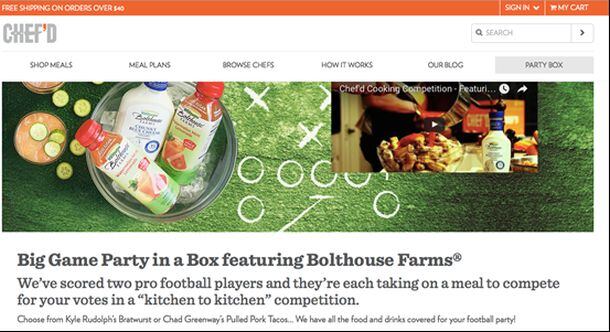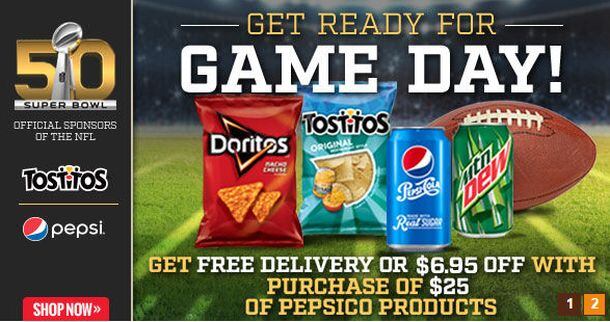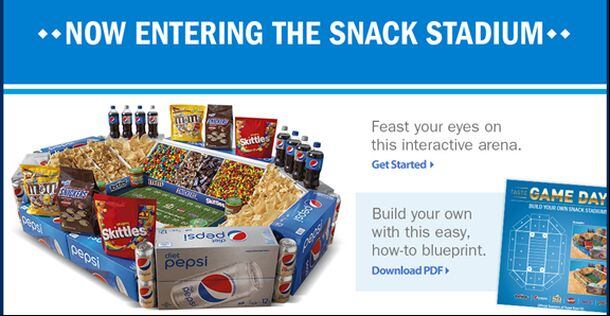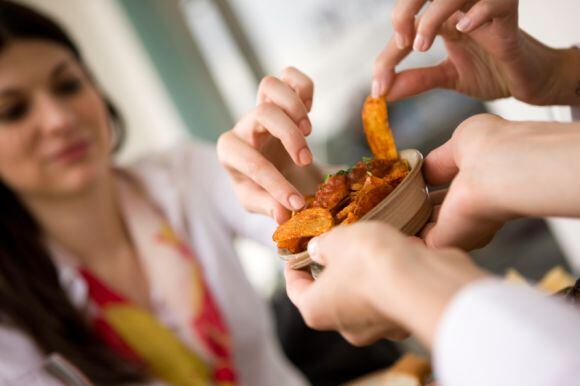During the window of demand leading up to the Super Bowl and those critical few hours during the big game, the key question for CPG brands and retailers, of course, will be how to increase event-driven food and beverage sales among consumers who are stocking up for or watching the big game.
The stakes are huge — on the field and off
According to a National Retail Federation’s (NRF) Super Bowl spending survey, nearly 43 million people hosted a Super Bowl party in 2015, and 80% of all viewers bought game day food and beverages. It’s no wonder the average viewer spent $77.88 on the Super Bowl last year, snapping up everything from snacks and beverages to team gear, new TVs and decorations. The total spend? $14.31 billion.
Yes, many people watch the Super Bowl for the express purpose of viewing the funny or heartwarming new commercials that advertisers have created specifically for the event. But for manufacturers and retailers of food and beverage brands, action takes place in the weeks and days leading up to the game — not simply as a TV buy for brand awareness, but as an integrated campaign across retail channels to drive measurable sales.
As the e-commerce channel has grown in significance as both a distribution and marketing channel, a growing number of CPG brands are aligning their online retail activities with key seasonal or event-driven demand windows.
Among the most effective merchandising and marketing vehicles are:
- sponsored results in category and search results at leading online retailers
- targeted email blasts
- virtual bundles of high-affinity, cross-category products like snacks and beverages
- sponsored shipping discounts (usually offered when shoppers buy some minimum of eligible products)
These vehicles put brands in a prime position on heavily-trafficked pages that shoppers already visit, as opposed to a standalone landing page that can’t deliver the same exposure.
They can also help compensate for the lack of ‘adjacencies’ in an online retail environment that are typically found in a bricks and mortar store, such as locating a selection of beer next to snacks. And they’re more measurable than many other vehicles, which is a growing challenge for brands as their trade and marketing budgets for e-commerce grow but their ability to measure effectiveness lags.
There are online tie-ins with TV, too. Some brands link from digital ads to pages featuring a pre-game release or teaser of a Super Bowl TV commercial — helping drive buzz. And more TV ads increasingly guide shoppers online, either through hashtags (for real-time reactions during the game) or to retailers’ sites, where they can buy the products they’ve just seen advertised.
According to the Calorie Control Council, the average Super Bowl viewer will consume 2,400 calories during the game.
Budweiser used the TV/online video combination to good effect last year by releasing online teaser photos and videos of a horse and puppy, and posting a ‘Lost Dog Reward’ that was actually a sweepstakes for Super Bowl tickets — all in advance of its puppy/horse-themed TV spots. Consumers who went online therefore felt more emotionally involved in the brand as they shopped in the days prior to kickoff.
Also worthy of note: The behemoth of online sales — Amazon — is getting in on the TV action, too. It just released a teaser video of its upcoming Super Bowl ad that promotes Echo, its voice-controlled virtual assistant — a spot that stars Alec Baldwin and former quarterback, Dan Marino, and marks Amazon’s Super Bowl debut.
Current examples of pre-game online food marketing in action
Turning to a purely online play, consider the example of Chef’d, a leading meal kit delivery service, which is collaborating with Bolthouse Farms, a longstanding produce provider and now owned by Campbell Soup Company.
Super Bowl TV ads increasingly guide shoppers online, either through hashtags (for real-time reactions during the game) or to retailers’ sites, where they can buy the products they’ve just seen advertised.
— the first of which features traditional Buffalo wings, and the second of which provides one of two specialty dishes inspired by current NFL players from the Minnesota Vikings — Kyle Rudolph (Rudolph’s Bratwurst Sandwiches) and Chad Greenway (Greenway’s 4-Hour Pulled Pork Tacos).
The digital campaign features hashtags and URLs that drive consumers to an online cooking competition that pits Rudolph against Greenway, and invites viewers to vote on their favorite meal kit. Those who vote can win prizes, including a tailgating package that takes them through next year’s NFL season. It’s a good example of the participatory, interactive nature of online promotions that can powerfully drive consumer interest and sales.

Other examples of pre-game promotions include Peapod teaming up with Pepsi to offer free delivery (or $6.95 off) with a purchase of $25. On Prime Pantry, Pepsi is offering ‘buy 5 PepsiCo products, get free shipping’ as part of the "Snack Stadium" promotion.

Walmart is also promoting a "build your own snack stadium" campaign by providing shoppers with a how-to guide and recommended snack foods to fill in each section.

The Amazon factor: Who’s winning before the big game?
Given Amazon’s prominent position in the e-commerce landscape and growing commitment to food and beverage sales, we took a look at Profitero’s Amazon FastMovers data, which benchmarks best-selling products at Amazon.
The top five brands in Profitero’s FastMovers for US Soft Drinks and Snack Foods for December, 2015 were:
US SOFT DRINKS
US SNACK FOODS
Among those names are the usual suspects — market-leading incumbent brands like Coca Cola, Pepsi [check out its Super Bowl ad for Mtn Dew Kickstart HERE] and Larabar.
But notably, among the top performers are emerging brands like Zevia and KIND, who may not have dominant distribution and shelf space in the brick-and-mortar retail channels but for whom e-commerce is a clear focus.
Also interesting are the pack configurations and price points among FastMovers in these categories. The average price for a soft drink item/multipack in December was $15.55 and $12.45 for snack foods. Given the unit economics of Amazon’s ‘national ship’ model, which requires a SKU’s price to offset the cost of delivery, multi-packs that hit price points in this range are not unusual. But the heavier consumption associated with big events like the Super Bowl is a great fit for larger pack-sizes often seen online.
Buyers can also get plenty of product reviews from other consumers — with an average of 405 reviews for soft drinks, and 804 for snack foods.

The average viewer spent $77.88 on the Super Bowl last year, snapping up everything from snacks and beverages to team gear, new TVs and decorations. The total spend? $14.31 billion.
Going mobile — before Super Bowl Sunday and during it
In addition to the ubiquity of Amazon, there’s another omnipresent factor: mobile. It’s everywhere — both for shopping and sports spectating. Over one-third of online video viewing of sporting events takes place on mobile devices. And approximately 50% of consumer visits to advertiser sites during the Super Bowl will come from mobile devices.
Of course, mobile visits don’t necessarily translate into mobile purchases, as many retailers have discovered. The fact is, visits far outstrip purchases — during and around Super Bowl Sunday, and every other day — and there’s a long way to go before retailers can convert mobile shoppers at the same rate as desktop shoppers.
As we approach the Super Bowl, much ongoing work is being done to simplify and optimize the buying experience on mobile devices. Online grocers are reporting significant percentages of transactions being completed on mobile devices, but qualify those statements by adding that basket-building generally originates on desktops and is later completed on mobile.
Approximately 50% of consumer visits to advertiser sites during the Super Bowl will come from mobile devices.
Still, mobile is the future. Just look at the spending patterns of Millennials, who spend more time on mobile than any other cohort. NRF data shows that young adults aged 18-24 spend an average of $95.92 on Super Bowl items, while viewers aged 25-34 spend an average of $101.54 — both significantly higher than the overall average of $77.88 cited earlier.
One final 'point after'
According to the Calorie Control Council, the average Super Bowl viewer will consume 2,400 calories during the game, making the Super Bowl the second biggest day for feasting after Thanksgiving.
As the fastest-growing retail channel, e-commerce may be a perfect match for food and beverage brands aiming to capitalize on the biggest sporting event of the year.

Keith Anderson is VP, strategy & insights at Profitero, where he helps global companies gain a deeper understanding of their online presence to optimize online and in-store sales. Anderson has advised leading retailers and CPG companies including Walmart, Target, Best Buy, P&G, Unilever and Coca Cola.
